- Stat Significant
- Posts
- Why Do People Hate Nickelback So Much? A Statistical Analysis
Why Do People Hate Nickelback So Much? A Statistical Analysis
Exploring the origins of Nickelback hatred.
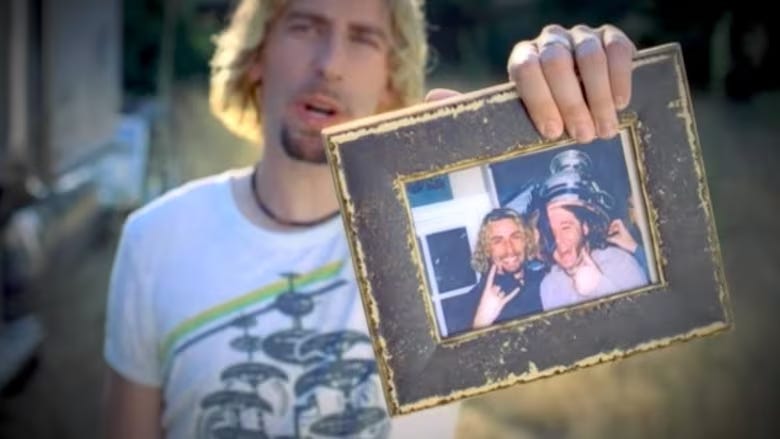
Nickelback’s “Photograph” music video. Credit: Roadrunner Records.
Intro: Nickelback, The Internet's Punching Bag
How does one explain Nickelback? And how does one explain the band's remarkable second life as a meme? Well, for starters, Nickelback is a post-grunge Canadian rock band that achieved significant commercial success in the 2000s and frequently faces considerable hostility on the internet.
The band has sold over 50 million albums worldwide, making them the 101st most successful music act of all time. And yet, hatred abounds:
In 2012, Buzzfeed ranked the band's hit single "Rockstar" as #2 on their list of the 30 Worst Songs Ever Written.
In 2013, Rolling Stone readers voted Nickelback the second worst band of the 90s (after Creed).
And in 2019, Variety ran an article claiming that Imagine Dragons had finally supplanted Nickelback as the worst band of all time (as if there is some long-running scoreboard).
Sure, the media dislikes Nickelback, but this animosity is simply an internet thing, a phenomenon confined to the digital realm, right? Not so. On November 3rd, 2011, the NFL announced Nickelback as its marquee act for the league's Thanksgiving halftime show, sparking protests from indignant Detroit fans who would be forced to watch the performance live.
A group of frustrated Michiganders quickly drafted an online petition to replace Nickelback, giving voice to Detroit's disgruntled fanbase:
This game is nationally televised, do we really want the rest of the US to associate Detroit with Nickelback? Detroit is home to so many great musicians and they chose Nickelback?!?!?! Does anyone even like Nickelback?
The petition obtained 55,199 signatures but failed to prevent a lukewarm Nickelback halftime show, as the band's set sparked widespread boos for the entirety of its five-minute runtime. Somehow, Nickelback hatred had metastasized, spreading to the physical world.
Since then, the myth of Nickelback's awfulness has only grown through gifs, worst-of polls, clickbait articles, comedian punchlines, and YouTube mashups. But why is Nickelback the internet's punching bag of choice, and what seeded this collective animosity? Is there a quantifiable explanation for all of this Nickelback hatred?

Check out Semafor Media—penned by Semafor's editor-in-chief and media columnist Ben Smith, Semafor Media dives into the political, cultural, and financial forces shaping global news organizations. With 20+ years of reporting experience at the helm, each issue is packed with thoughtful analysis, and the occasional big scoop.
Hypothesis #1: Nickelback Is Overplayed
What does it mean to be overplayed? In theory, music consumption should function like any market—the public's desire to hear a musician should dictate a song or artist's distribution. So what does it mean when critics claim Nickelback is "overplayed"?
Perceived overexposure likely results from a gap between critical acclaim and commercial success. On the commercial side of this equation, album sales and streams influence an artist's syndication, with increased consumption cementing hit songs as staples of radio rotations and Spotify playlists—thus making this music unavoidable. How tastemakers and digital communities subsequently receive these works informs internet discourse, propagating critiques (or praise) of these now-inescapable songs.
If a song or album is best-selling but low in acclaim, we can consider it "overexposed," loathed by a sizable audience who detests this music. Our analysis will utilize US-based album sales as a proxy for commercial success and Metacritic user ratings as a marker of critical acclaim. When we graph artists with more than 3M albums sold, Nickelback stands as a clear-cut outlier—above average in commercial performance and well below average when it comes to acclaim:
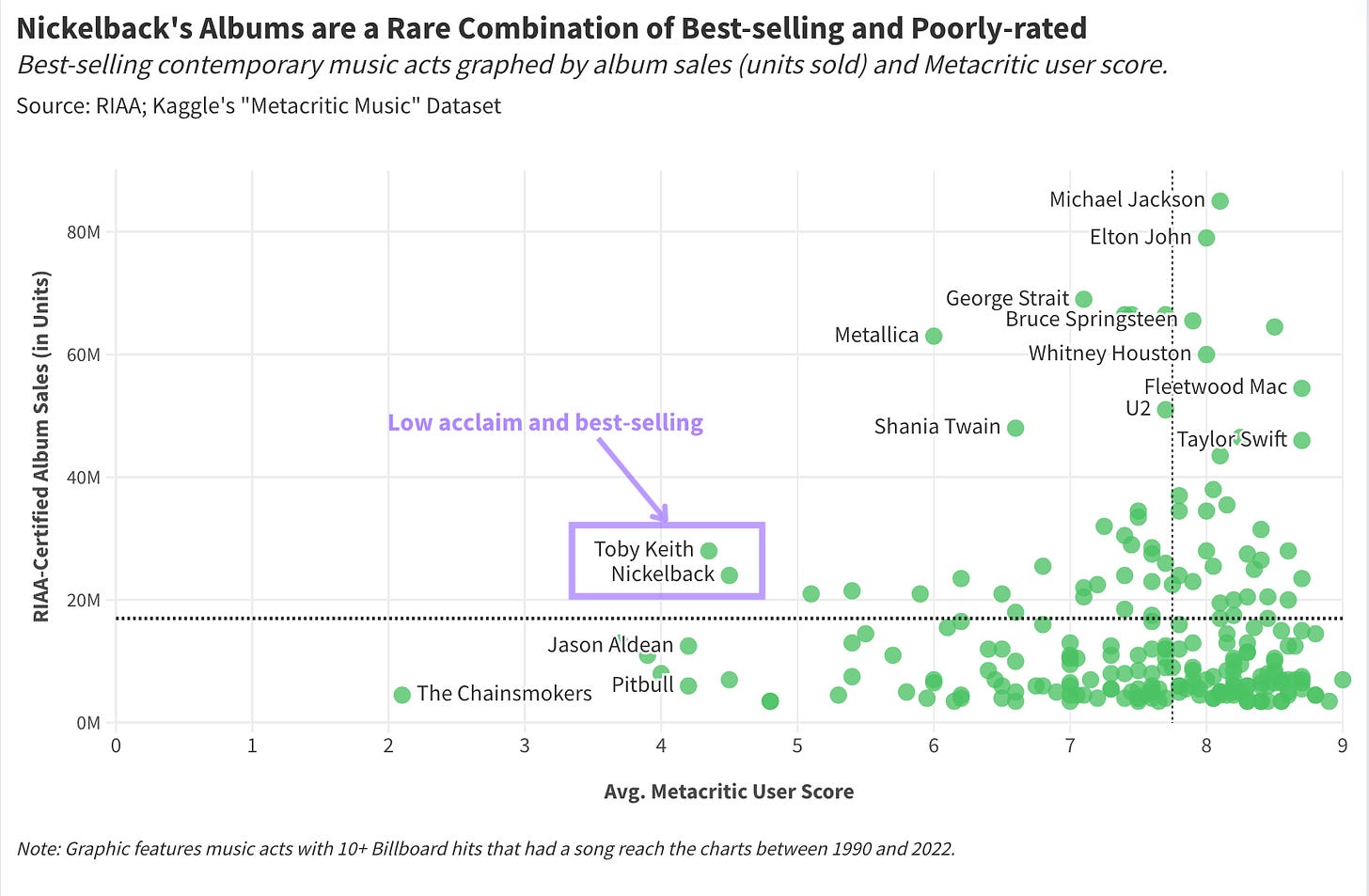
Nickelback's low user scores don't mean the band is universally despised; instead, there is likely a sizable contingent of vigilant music consumers who strongly disapprove of Nickelback and cannot evade their songs.
But Nickelback's status as "overplayed" may be a relic of music's pre-streaming era—a time before algorithmic personalization and cultural fragmentation. In the 1990s and 2000s, music video programming and radio stations were the go-to media formats for music discovery, as TV channels like MTV and VH1 maintained considerable influence over popular taste. Spotify and streaming would later disrupt music distribution as sonic exploration became increasingly individualized, with consumers gaining greater control over their discovery experience. Suddenly, music lovers could indulge in niche genres, curate a playlist, and avoid an undesirable artist, free from the tyranny of a potential Nickelback successor.
Hypothesis #2: Nickelback's Music Is Repetitive
In 2017, Karl Puschmann of the New Zealand Herald listened to all 89 Nickelback songs to better comprehend the band's unique reputation. In recapping his project, Puschman highlights Nickelback's repetitiveness as a critical feature of the band's distinctive "sonic torture":
"Having now listened to every one of their songs - including the new one—I can authoritatively state that Nickelback have 89 different titles for three songs. Predominantly they stick to a mid-tempo rock chug that they occasionally speed up or slow down."
Puschman isn't alone in this opinion, as numerous YouTube videos delight in layering Nickelback songs atop one another to highlight the band's repetitiveness. At the same time, many artists utilize a signature sound throughout their discography, so is Nickelback special in its lack of variety?
We can utilize Spotify's dataset of music attributes to quantify the uniformity of Nickelback songs relative to other best-selling acts. Using data points like song energy, loudness, and danceability, we'll calculate sonic variance across an artist's catalog of hits and then rank musicians by average variance.
For example, we can compare variance in song energy and danceability for U2, ABBA, and Katy Perry, then rank these artists against each other. According to this subset of variables, ABBA's discography offers greater sonic variety than U2's or Katy Perry's.

When we run this analysis on Spotify's entire feature set for artists with 10 or more Billboard hits, Nickelback ranks in the top 10 for low-variability music acts, just behind several country music stars (a polarizing genre in its own right):
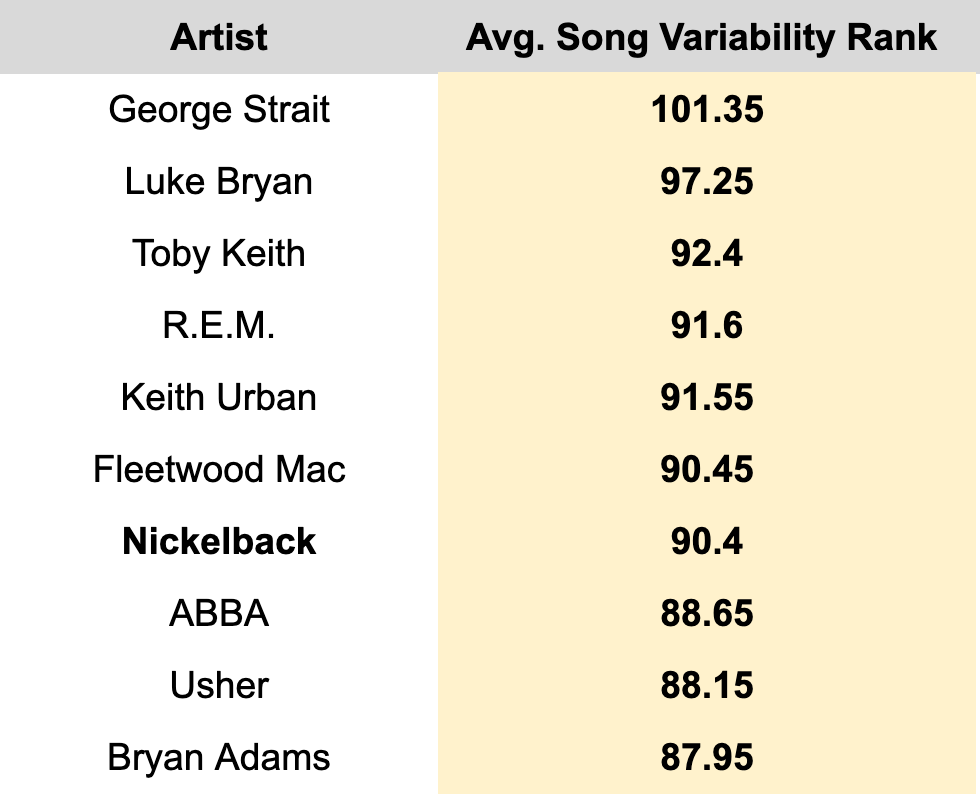
Best-selling artists with the lowest levels of sonic variability.
We can then graph this average variability ranking against record sales, similar to the two-by-two approach used for critical acclaim. When we chart these variables, Nickelback places in the high-sales, low-variability quadrant:
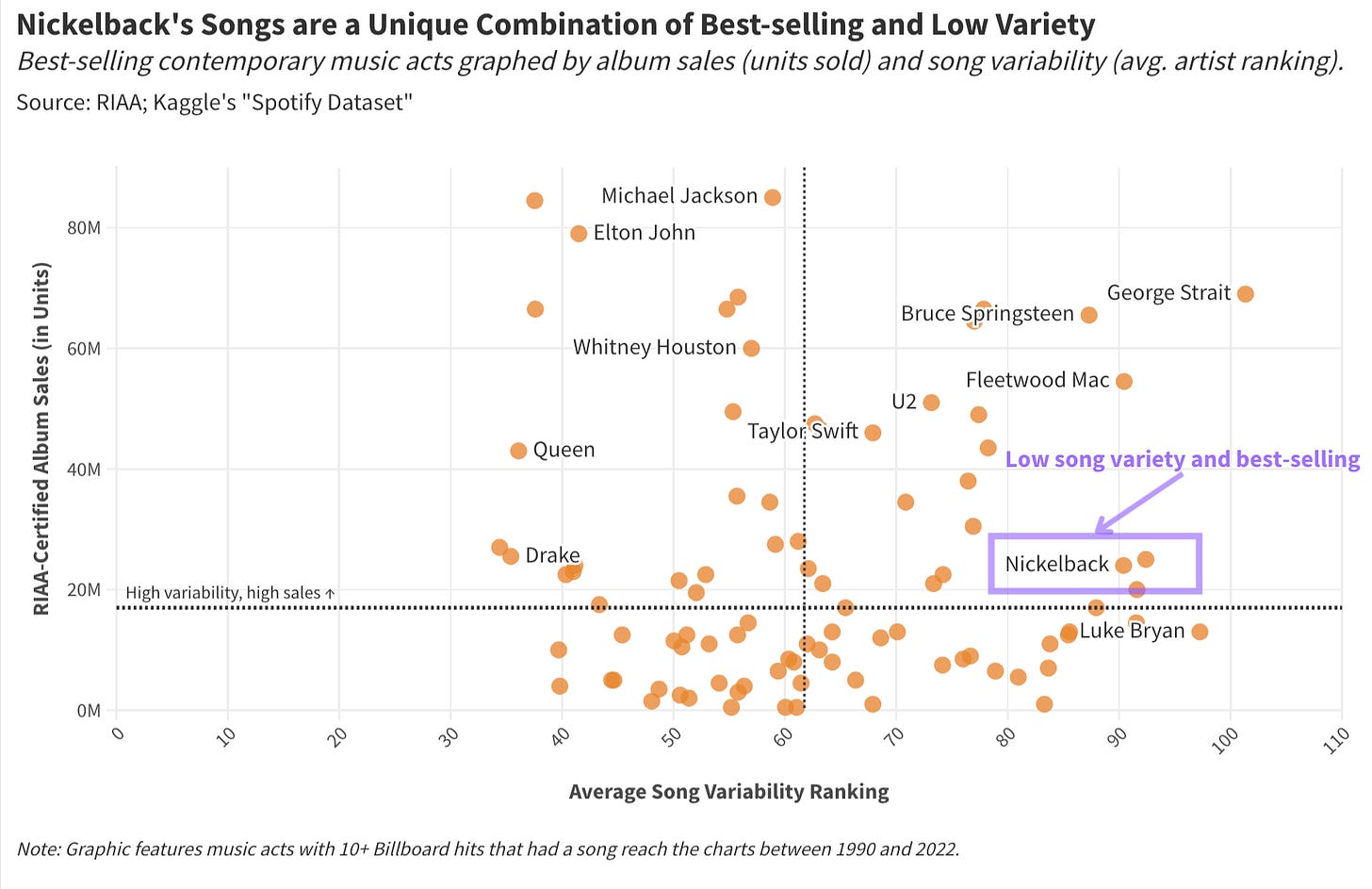
Does this mean Bruce Springsteen and Fleetwood Mac (artists who qualify as high sales and lower variability) should also be the subject of wanton internet hostility? No. Rather, a unique combination of ubiquity and uniformity would exacerbate existing frustrations with a polarizing musician. So, if someone is predisposed to dislike Nickelback, Bruce Springsteen, or George Strait, then widely played songs that sound the same will increasingly enrage that listener. Consider the band's perceived lack of variety as fuel added to the growing fire of Nickelback animosity.
Need Help with a Data Project?

Enjoying the article thus far and want to chat about data and statistics? Need help with a data or research project? Well, you’re in luck because Stat Significant offers data science and data journalism consulting services. Reach out if you’d like to learn more.
Email [email protected]
Hypothesis #3: Sociopolitical Factors May Contribute To Nickelback Hatred (I'm Not Kidding)
I did not set out to write an article about identity politics or the US culture wars; I simply want to write about a band with a terrible reputation. And yet here we are.
As I traversed the deep recesses of Nickelback internet hostility, I became increasingly obsessed with a single question: If Nickelback is so widely despised, then who is buying these albums? What explains the enormous gap between remarkable record sales and hyper-critical media coverage? Unfortunately, geopolitics may play a role.
While investigating Nickelback search data, I noticed a pattern in the band's YouTube search traffic—query volume ranks highest in right-leaning US states.
Alas, when we graph YouTube search data against state GOP vote share from the 2020 US presidential election, we find a strong correlation between Nickelback interest and Republican voter margin:
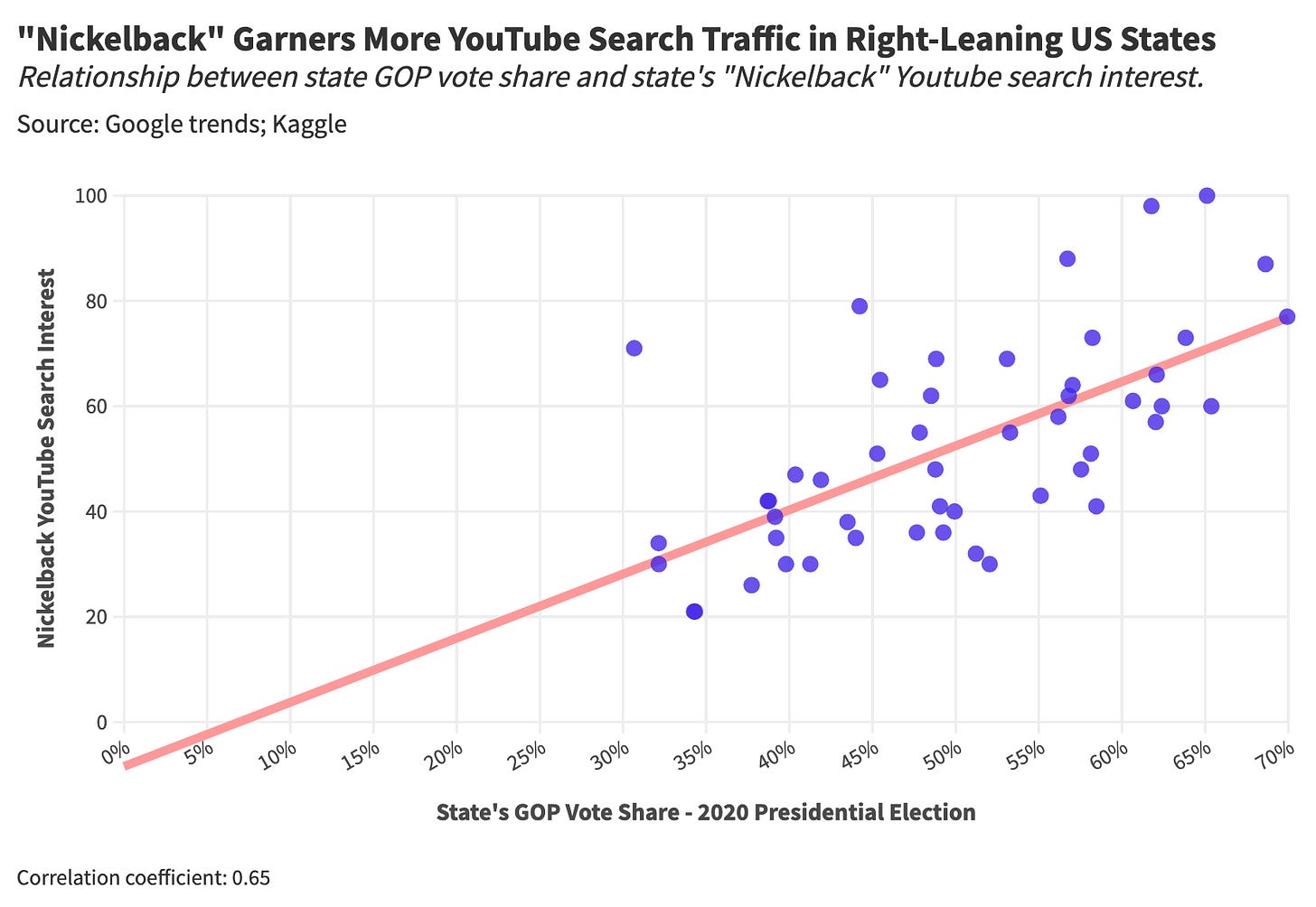
Does this mean Nickelback is the victim of a leftist plot to shadow ban their music? Doubtful—that would take a lot of organization for no gain or discernible purpose. More likely, Nickelback may be less appealing to liberals who happen to dominate prominent media outlets.
The band is consistently labeled as post-grunge with a tinge of country music influence, and all our previously investigated metrics group Nickelback amongst country music stars like George Strait, Luke Bryan, and Jason Aldean. So maybe this Canadian rock band somehow elicits the allure (and polarizing effects) of country music while technically being classified as grunge? If true, that's highly nuanced commercial appeal for a band accused of overwhelming simplicity.
Hypothesis #4: Nickelback Is The Victim of Unlucky Publicity
Nickelback consistently receives unenviable publicity originating from events outside their control. One of the band's greatest PR nightmares involves a once-ubiquitous TV advertisement for a long-forgotten comedy show.
Tough Crowd With Colin Quinn premiered on Comedy Central in late 2002. The program featured a panel of guest comedians discussing current affairs, each news item subject to pithy quips and silly takedowns. On a now-infamous episode, the Tough Crowd panel examined a study linking popular music and violence, to which comedian Brian Posehn joked: "No one talks about the studies which show that bad music makes people violent. Like, Nickelback makes me wanna kill Nickelback."
This wisecrack was not particularly memorable, but Comedy Central included the joke in a long-running advertisement for Tough Crowd. And this promo ran a lot.
In a 2022 interview, Nickelback frontman Chad Kroeger pinpointed the Colin Quinn ad as a turning point for the band's reputation:
"They took [that joke], they put it in a commercial for that one show. And that played on Comedy Central for six months straight, this Nickelback joke. That starts this whole thing going. That's where it really started, at that one moment."
To comprehend the scale and influence of this Tough Crowd ad, we can estimate the promo's viewership over the entirety of its run. By combining assumptions about Comedy Central viewership, the number of promo airings per day, and the duration of the promotional campaign, we can estimate advertising impressions:
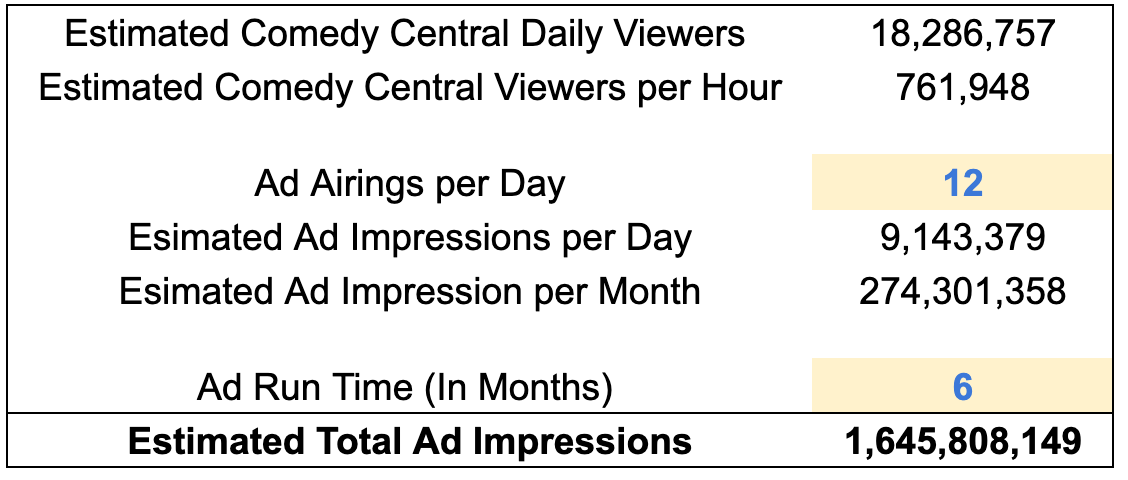
Since there is no data on daily ad frequency or campaign length, we can produce a range of estimates by varying our assumptions:

According to our calculations, the Tough Crowd ad could have generated anywhere between 1,645,808,149 and 6,583,232,598 ad impressions, assuming a six to twelve-month run and 12 to 24 airings a day. I guess one well-marketed joke can do serious damage.
But the Colin Quinn promo was simply one of many incidents of widespread Nickelback animosity. When we examine search queries for "Nickelback Hate," we find the term exploded into the zeitgeist in late 2011:
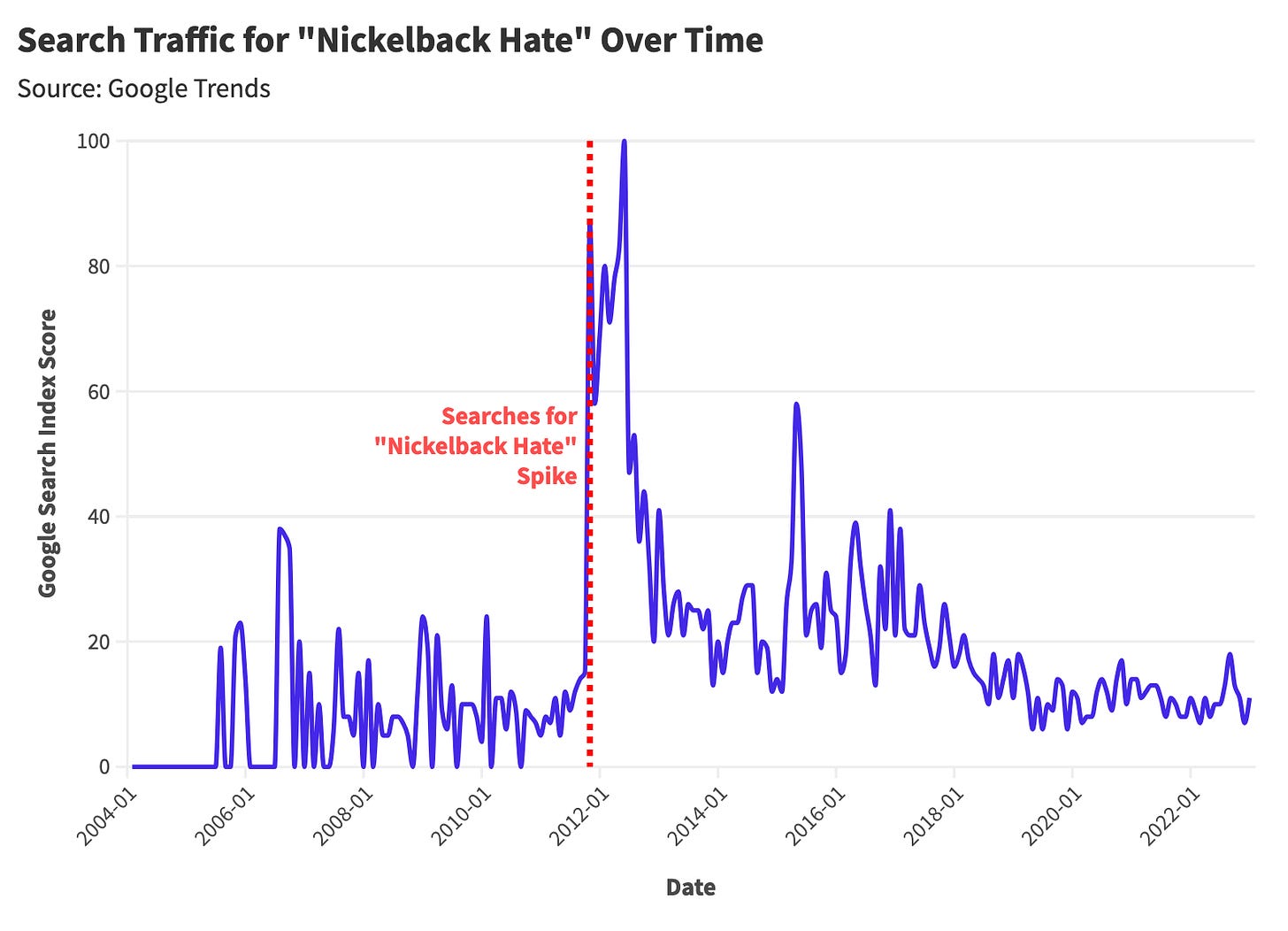
According to Google data, November 2011 serves as a tipping point for Nickelback hostility, with minimal internet traffic before this period and a constant stream of search traffic after this point. So what happened? Well, the Detroit Lions Thanksgiving halftime show is what happened.
Perhaps this spirited petition formalized long-dormant Nickelback grievances. Suddenly, it was fashionable to dunk on Nickelback. All the long-standing frustrations—overplayed music, repetitiveness, cultural preference, and unique priming from a Comedy Central commercial—came together in a highly public spectacle of Nickelback bashing. The Nickelback meme had gone mainstream.
Final Thoughts: The Success of Nickelback, The Idea

Nickelback’s “How You Remind Me” music video. Credit: Roadrunner Records.
Biologist Richard Dawkins coined the term "meme" in his 1976 bestseller The Selfish Gene, stating that a meme "conveys the idea of a unit of cultural transmission, or a unit of imitation." Dawkins would further elaborate on this construct by framing the spread of cultural beliefs in Darwinian terms:
"Just as genes propagate themselves in the gene pool by leaping from body to body via sperms or eggs, so memes propagate themselves in the meme pool by leaping from brain to brain, via a process which, in the broad sense, can be called imitation."
According to Dawkins, ideas replicate and spread in a process reminiscent of natural selection: some ideas take root and survive, while others lose mind share over time. So what explains the longevity of the Nickelback meme? Nickelback's commercial career peaked in the late 2000s, yet their cultural relevance has grown over time. How is this possible?
Nickelback's mimetic staying power doesn't arise from any one idea but rather an amalgamation of spirited grievances. The band is a Rorschach test for everything you find wrong with modern music—you see what you want to dislike.
To some, Nickelback signifies the pitfalls of over-commercialized music. To some, Nickelback's success stems from those on the opposite end of a geopolitical divide. And to some, Nickelback is simply internet shorthand for bad.
Nickelback is an incredibly successful idea—at the expense of the band itself.
Thanks for reading Stat Significant! Subscribe for free to receive new posts and support my work.
Want to chat about data and statistics? Have an interesting data project? Just want to say hi? Email [email protected]